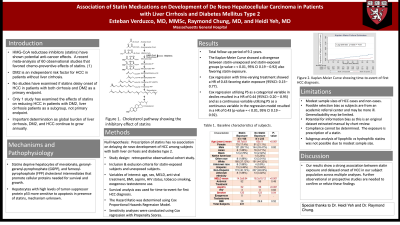Tuesday Poster Session
Category: Liver
P3775 - Association of Statin Medications on Development of de novo Hepatocellular Carcinoma in Patients With Liver Cirrhosis and Diabetes Mellitus Type 2
Tuesday, October 24, 2023
10:30 AM - 4:00 PM PT
Location: Exhibit Hall


Esteban Verduzco, MD
Harvard
Visalia, CA
Presenting Author(s)
Esteban Verduzco, MD, Raymond Chung, MD, Heidi Yeh, MD
Harvard, Boston, MA
Introduction: Statin exposure and the association with decreased incidence of hepatocellular carcinoma (HCC) in subjects with liver cirrhosis and diabetes mellitus type 2 (DM2) has been sparsely studied. Numerous other observational studies and meta-analyses have demonstrated an association with statin exposure and delayed onset of HCC in subjects with liver cirrhosis alone, but not with co-morbid DM2.
Methods: In this retrospective observational cohort study, we selected 423 subjects with liver cirrhosis and DM2 from the Massachusetts General Brigham health care system from 1 January 2004 to 25 July 2022. Data on statin usage, date of death, date of HCC, and confounders known to increase the risk of HCC were collected. Survival analysis was conducted for time to event to first HCC. We determined the hazard ratio for the association using Cox Proportional Hazards Regression Model. Additional sensitivity analyses were conducted with Cox regression with Propensity Score (PS) as a variable in the model, first as a continuous variable, and then as a categorical variable (decile groups) as well.
Results: The total follow-up period was 9.2 years. The Kaplan-Meier Curve showed a divergence between statin unexposed and statin exposed groups (p-value = < 0.01) when treating statin exposure as time-fixed. Cox regression with time-varying treatment showed a HR of 0.43 favoring statin exposure (95%CI: 0.15–0.77). Cox 8 regression utilizing PS as a categorical variable in the regression model in deciles resulted in a HR of 0.44 (95%CI: 0.20 – 0.95), and Cox regression utilizing PS as a continuous variable in the regression model resulted in a HR of 43 (p-value = >< 0.01, 95% CI 0.19 – 0.92) also favoring statin exposure. Cox regression model showed a favorable hazard ratio of 0.43 (p-value = < 0.01, 95% CI 0.20 – 0.95) for statin exposure. Cox regression using propensity scoring as a categorical variable in the model for each decile group for the statin variable resulted in an overall HR of 0.44 (p-value 0.04, 95% CI 0.20 – 0.96). When the Cox regression model was used with a propensity score as a continuous variable, the statin variable resulted in a favorable HR of 0.43 (p-value = < 0.01, 95% CI 0.19 – 0.92).
Discussion: Our results show a strong association between statin exposure and delayed onset of HCC in our subject population of subjects with liver cirrhosis and DM2 diagnoses across multiple analyses. Further observational or prospective studies are needed to confirm or refute these findings.
Disclosures:
Esteban Verduzco, MD, Raymond Chung, MD, Heidi Yeh, MD. P3775 - Association of Statin Medications on Development of de novo Hepatocellular Carcinoma in Patients With Liver Cirrhosis and Diabetes Mellitus Type 2, ACG 2023 Annual Scientific Meeting Abstracts. Vancouver, BC, Canada: American College of Gastroenterology.
Harvard, Boston, MA
Introduction: Statin exposure and the association with decreased incidence of hepatocellular carcinoma (HCC) in subjects with liver cirrhosis and diabetes mellitus type 2 (DM2) has been sparsely studied. Numerous other observational studies and meta-analyses have demonstrated an association with statin exposure and delayed onset of HCC in subjects with liver cirrhosis alone, but not with co-morbid DM2.
Methods: In this retrospective observational cohort study, we selected 423 subjects with liver cirrhosis and DM2 from the Massachusetts General Brigham health care system from 1 January 2004 to 25 July 2022. Data on statin usage, date of death, date of HCC, and confounders known to increase the risk of HCC were collected. Survival analysis was conducted for time to event to first HCC. We determined the hazard ratio for the association using Cox Proportional Hazards Regression Model. Additional sensitivity analyses were conducted with Cox regression with Propensity Score (PS) as a variable in the model, first as a continuous variable, and then as a categorical variable (decile groups) as well.
Results: The total follow-up period was 9.2 years. The Kaplan-Meier Curve showed a divergence between statin unexposed and statin exposed groups (p-value = < 0.01) when treating statin exposure as time-fixed. Cox regression with time-varying treatment showed a HR of 0.43 favoring statin exposure (95%CI: 0.15–0.77). Cox 8 regression utilizing PS as a categorical variable in the regression model in deciles resulted in a HR of 0.44 (95%CI: 0.20 – 0.95), and Cox regression utilizing PS as a continuous variable in the regression model resulted in a HR of 43 (p-value = >< 0.01, 95% CI 0.19 – 0.92) also favoring statin exposure. Cox regression model showed a favorable hazard ratio of 0.43 (p-value = < 0.01, 95% CI 0.20 – 0.95) for statin exposure. Cox regression using propensity scoring as a categorical variable in the model for each decile group for the statin variable resulted in an overall HR of 0.44 (p-value 0.04, 95% CI 0.20 – 0.96). When the Cox regression model was used with a propensity score as a continuous variable, the statin variable resulted in a favorable HR of 0.43 (p-value = < 0.01, 95% CI 0.19 – 0.92).
Discussion: Our results show a strong association between statin exposure and delayed onset of HCC in our subject population of subjects with liver cirrhosis and DM2 diagnoses across multiple analyses. Further observational or prospective studies are needed to confirm or refute these findings.
Disclosures:
Esteban Verduzco indicated no relevant financial relationships.
Raymond Chung indicated no relevant financial relationships.
Heidi Yeh indicated no relevant financial relationships.
Esteban Verduzco, MD, Raymond Chung, MD, Heidi Yeh, MD. P3775 - Association of Statin Medications on Development of de novo Hepatocellular Carcinoma in Patients With Liver Cirrhosis and Diabetes Mellitus Type 2, ACG 2023 Annual Scientific Meeting Abstracts. Vancouver, BC, Canada: American College of Gastroenterology.
